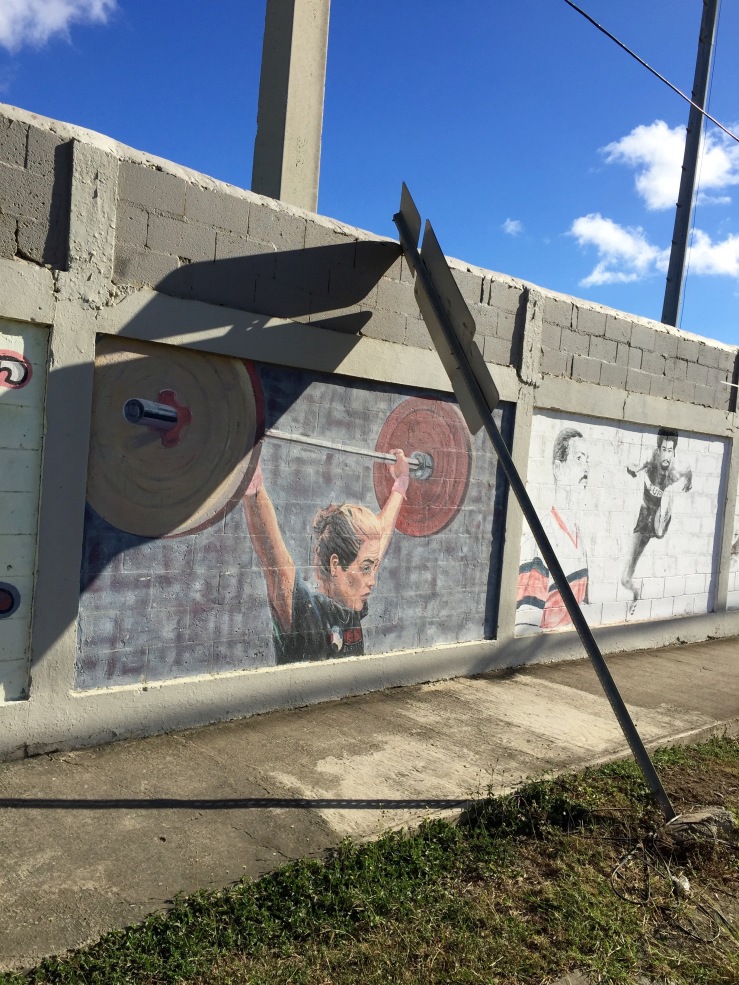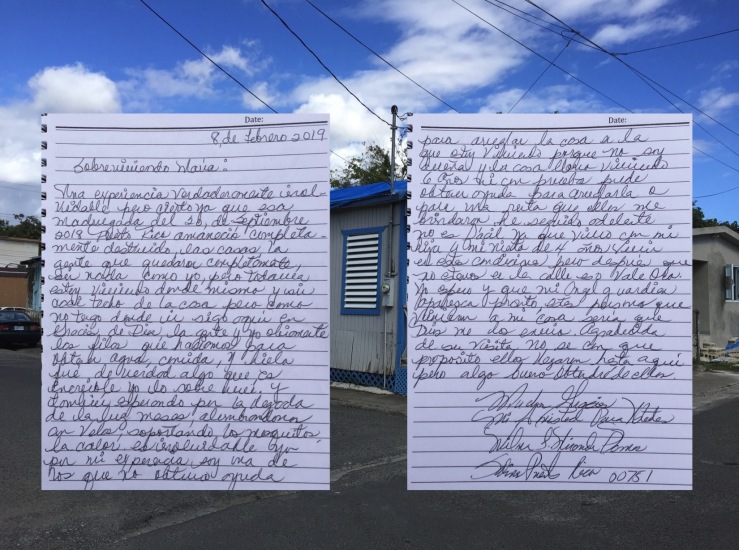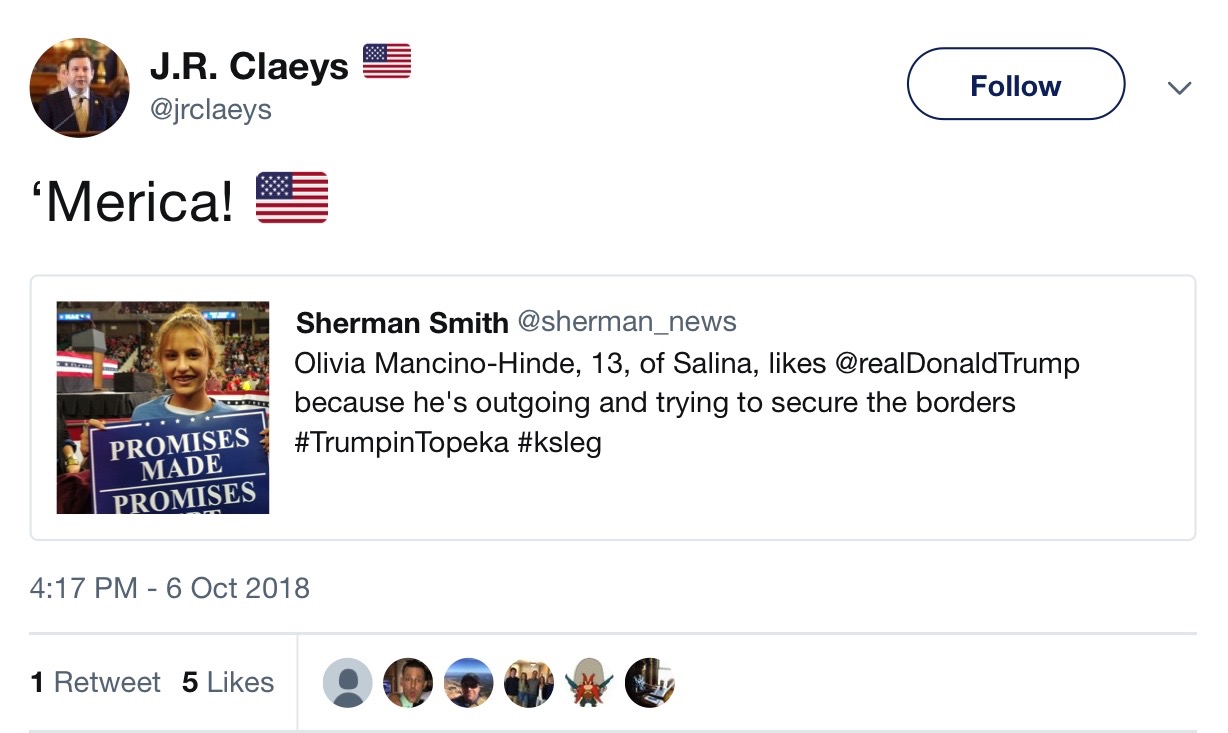See also at Common Dreams
This is an island surrounded by water, big water, ocean water — Donald Trump, INDEPENDENT, September 29, 2017.
This is a three-part photo essay accompanying an article by Stan and Paul Cox, titled ‘Vulnerable Americans Are Still Trapped in the Ruins Left by Hurricane Maria.’
Superpower Neglect: There’s Something About a Neighbor (part 3)
The United States government would rather have us remain silent about who we might meet with and talk to in Puerto Rico about Hurricane Maria, the destruction it caused, and how the mainland responded…
 …such as always-smiling Fela Suren who says she’s “80-something.” She wasn’t in her house when Maria made landfall, but was staying with a friend. She said she started screaming “Ahhhhhhh!” when the hurricane struck, and she doesn’t wish to see anything like another Maria ever again. She laughs and adds that she wants to go to the United States…
…such as always-smiling Fela Suren who says she’s “80-something.” She wasn’t in her house when Maria made landfall, but was staying with a friend. She said she started screaming “Ahhhhhhh!” when the hurricane struck, and she doesn’t wish to see anything like another Maria ever again. She laughs and adds that she wants to go to the United States…
 …or remain silent about Fela’s undrinkable green tap water that she says she only bathes with…
…or remain silent about Fela’s undrinkable green tap water that she says she only bathes with…
…or the papaya and gandules trees that she planted in her yard…
 …or this montage of her roofless, destroyed home that includes a makeshift bedroom in her kitchen with the boarded window…
…or this montage of her roofless, destroyed home that includes a makeshift bedroom in her kitchen with the boarded window…
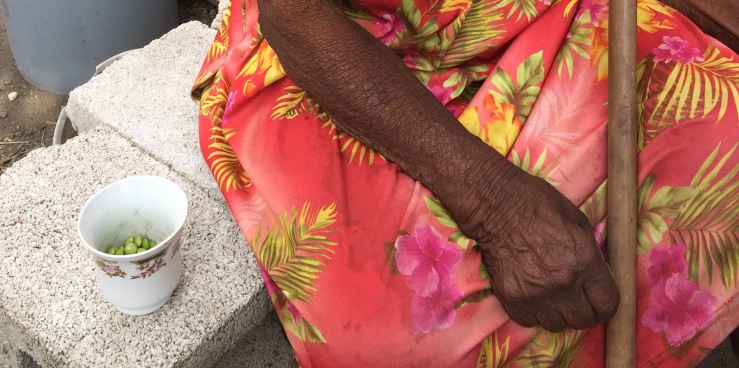 …or the pods from her gandules trees that lie strewn about on the dirt and that she sweeps off with her pink broom and breaks into a broken white cup to cook with and eat…
…or the pods from her gandules trees that lie strewn about on the dirt and that she sweeps off with her pink broom and breaks into a broken white cup to cook with and eat…
 …or, maybe while she sits, waiting for people from the church that “adopted” her to come and put new windows into her unfinished home…
…or, maybe while she sits, waiting for people from the church that “adopted” her to come and put new windows into her unfinished home…
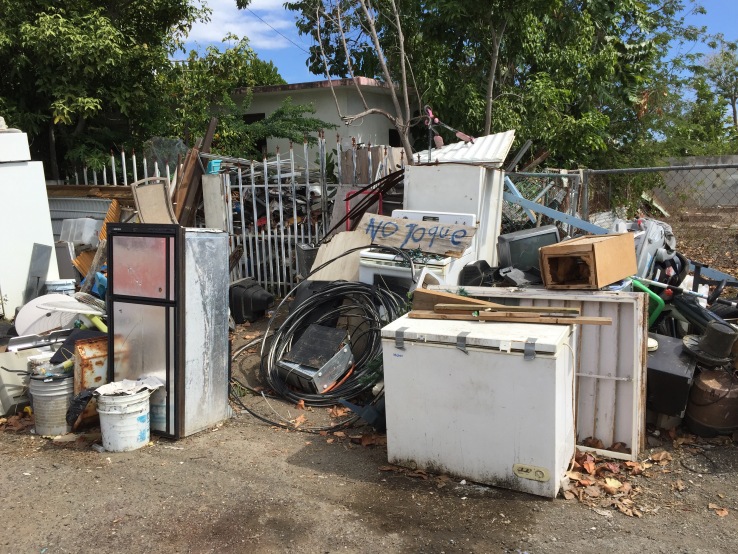 …or this inside-out-home with a sign that says ‘No Toque’ (Do Not Touch), because of the mistaken belief that “FEMA is coming…”
…or this inside-out-home with a sign that says ‘No Toque’ (Do Not Touch), because of the mistaken belief that “FEMA is coming…”
 …or this Maria-brush-picket-fence…
…or this Maria-brush-picket-fence…
 …or this photo of then-young, now-96-year-old Juana San Miguel with her mother Evarista Diaz and stepdad Alfonzo Cruz…
…or this photo of then-young, now-96-year-old Juana San Miguel with her mother Evarista Diaz and stepdad Alfonzo Cruz…
 …or about our guide and translator Madeline Flores Tenazoa (left), Juana San Miguel (center), or Victoria Febás…
…or about our guide and translator Madeline Flores Tenazoa (left), Juana San Miguel (center), or Victoria Febás…
 …and the fact that Juana, who will turn 97 this May and worked in a garment factory for 30 years, never missed a day’s work in her life; or that Victoria worked for the government as a nurse, and they both live on social security and are two of the elderly people who are the majority in Sierra Brava. “We have good neighbors here” says Juana. Both of them live by themselves, and neither of them drive or have a car. “Almost all old people here,” says Madeline. “Every time they [the neighbors] check if they need something” from the supermarket, or any other help…
…and the fact that Juana, who will turn 97 this May and worked in a garment factory for 30 years, never missed a day’s work in her life; or that Victoria worked for the government as a nurse, and they both live on social security and are two of the elderly people who are the majority in Sierra Brava. “We have good neighbors here” says Juana. Both of them live by themselves, and neither of them drive or have a car. “Almost all old people here,” says Madeline. “Every time they [the neighbors] check if they need something” from the supermarket, or any other help…
 …or that Victoria, who, framed by portraits of her family on the wall behind her, can be seen here, smiling, wearing her beloved chihuahua Lindita on her right wrist like an oversize bracelet, and with her left hand holding a photo of her son, Ramon, who, like Wilma’s son, Juan Carlos (see part 1), serves in the United States Army…
…or that Victoria, who, framed by portraits of her family on the wall behind her, can be seen here, smiling, wearing her beloved chihuahua Lindita on her right wrist like an oversize bracelet, and with her left hand holding a photo of her son, Ramon, who, like Wilma’s son, Juan Carlos (see part 1), serves in the United States Army…
 …or the sticker next to the rippling wall-paint showing signs of water seepage, that says ‘There’s something about a soldier.’ Madeline tells us that Victoria’s neighbor, who was living across the street, had to leave because he, like many, couldn’t find a job in Sierra Brava. She said that he did a lot for Victoria. If she needed anything from the supermarket, for instance, she only had to cross the street and ask him and he would bring whatever she needed. But now she has to wait for her daughter to come from San Juan to go to the supermarket. “There’s something about a soldier” works great in the U.S. mainland where cowards make the rules and young citizens like Ramon who fought in Afghanistan serve and die for them. But in the island territory of Puerto Rico, “There’s something about a neighbor” rings more true…
…or the sticker next to the rippling wall-paint showing signs of water seepage, that says ‘There’s something about a soldier.’ Madeline tells us that Victoria’s neighbor, who was living across the street, had to leave because he, like many, couldn’t find a job in Sierra Brava. She said that he did a lot for Victoria. If she needed anything from the supermarket, for instance, she only had to cross the street and ask him and he would bring whatever she needed. But now she has to wait for her daughter to come from San Juan to go to the supermarket. “There’s something about a soldier” works great in the U.S. mainland where cowards make the rules and young citizens like Ramon who fought in Afghanistan serve and die for them. But in the island territory of Puerto Rico, “There’s something about a neighbor” rings more true…
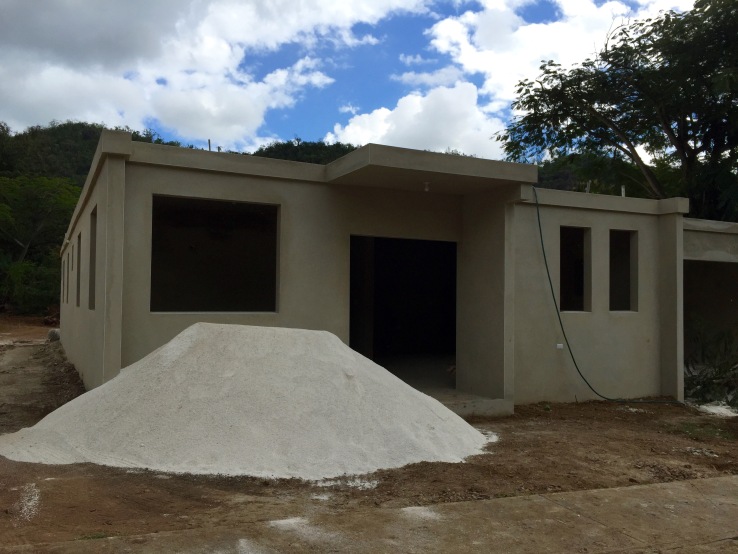 …or this piece of land where Madeline’s grandmother’s old house stood. “My grandmother [was] born here…When I came [to live here] I was only 11 days old, and my grandmother was living here with her mom. We had [two] big trees here,” says Madeline, and the day that Maria struck, they fell and “broke the house in two pieces.” Her cousin — who had bought the old house — was here during Maria. When the house was destroyed, Madeline says “my grandmother went crazy… she told everybody she needed to come to see [for herself] what happened, and she started crying! crying!… the house is not the same, now it’s a new house… she say I passed all my life there, and my dad died there, I saw mama die there…” (La Plena, Puerto Rico)
…or this piece of land where Madeline’s grandmother’s old house stood. “My grandmother [was] born here…When I came [to live here] I was only 11 days old, and my grandmother was living here with her mom. We had [two] big trees here,” says Madeline, and the day that Maria struck, they fell and “broke the house in two pieces.” Her cousin — who had bought the old house — was here during Maria. When the house was destroyed, Madeline says “my grandmother went crazy… she told everybody she needed to come to see [for herself] what happened, and she started crying! crying!… the house is not the same, now it’s a new house… she say I passed all my life there, and my dad died there, I saw mama die there…” (La Plena, Puerto Rico)
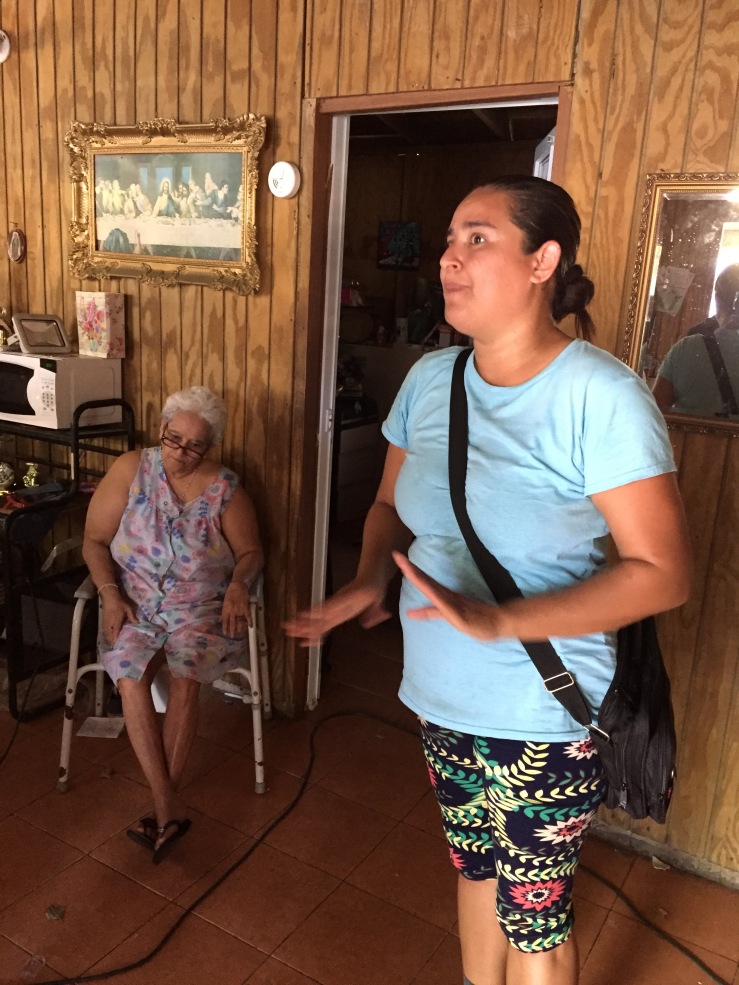 …or about Madeline’s grandmother, 78-year-old Milagros Colón, whose home in Sierra Brava was also destroyed by the hurricane. Madeline tells us that “the tree fell [through the roof] and the water came inside from the river and she lost everything. They [FEMA] came, but my grandmother she doesn’t speak English. How’s she gonna talk with him. How?” Later, “they send the letter [saying] you qualify only for $400, but what’re you going to pay [for all that was destroyed] with $400? Madeline says that the tree was on Milagros’ bedroom side of the house and when it fell, the bedroom window came crashing down on her grandmother’s bed. “Thank God she wasn’t here! [when it happened.] I was in the United States, but I called my grandmother [and told her] you please don’t stay in the house. My uncle lives in an apartment on the second floor.” She says Milagros wanted to stay but Madeline insisted “you can go [there], you need to go!… She says she feels the consequences [of the disaster] now,” a year and a half later…
…or about Madeline’s grandmother, 78-year-old Milagros Colón, whose home in Sierra Brava was also destroyed by the hurricane. Madeline tells us that “the tree fell [through the roof] and the water came inside from the river and she lost everything. They [FEMA] came, but my grandmother she doesn’t speak English. How’s she gonna talk with him. How?” Later, “they send the letter [saying] you qualify only for $400, but what’re you going to pay [for all that was destroyed] with $400? Madeline says that the tree was on Milagros’ bedroom side of the house and when it fell, the bedroom window came crashing down on her grandmother’s bed. “Thank God she wasn’t here! [when it happened.] I was in the United States, but I called my grandmother [and told her] you please don’t stay in the house. My uncle lives in an apartment on the second floor.” She says Milagros wanted to stay but Madeline insisted “you can go [there], you need to go!… She says she feels the consequences [of the disaster] now,” a year and a half later…
 …or about what many Puerto Rican’s felt about Donald Trump’s hurricane-response behavior. “If you see what happened when Trump came, and, he laugh, everybody laugh, with the paper towel. Ah, you can get this [paper towels], like… this?! You can clean your nose with this, but how I’m gonna to repair my house?… A lot of people were like ‘ha! ha! ha! oh, this is funny!’ It’s not funny. You are bullying the people.” Madeline alludes to Donald putting bully words in peoples’ mouths. Especially the children. “We need to repair everybody’s [houses]…he’s the first man [she laughs] and you do this with the people?…when the hurricane passed, a lot of kids’ parents [couldn’t] buy clothes again. They can’t buy backpacks, notebooks… and a lot of kids go like, ‘oh, your mom can’t buy you this? I have this!’…We need to stop. But it’s the same when you see in the news the government behaved the same with us! You try to tell the kids, ‘you need to stop [bullying]’, but they see the news, they see stuff in Facebook and they want to repeat…”
…or about what many Puerto Rican’s felt about Donald Trump’s hurricane-response behavior. “If you see what happened when Trump came, and, he laugh, everybody laugh, with the paper towel. Ah, you can get this [paper towels], like… this?! You can clean your nose with this, but how I’m gonna to repair my house?… A lot of people were like ‘ha! ha! ha! oh, this is funny!’ It’s not funny. You are bullying the people.” Madeline alludes to Donald putting bully words in peoples’ mouths. Especially the children. “We need to repair everybody’s [houses]…he’s the first man [she laughs] and you do this with the people?…when the hurricane passed, a lot of kids’ parents [couldn’t] buy clothes again. They can’t buy backpacks, notebooks… and a lot of kids go like, ‘oh, your mom can’t buy you this? I have this!’…We need to stop. But it’s the same when you see in the news the government behaved the same with us! You try to tell the kids, ‘you need to stop [bullying]’, but they see the news, they see stuff in Facebook and they want to repeat…”
 …or of this tough little tree in Central Aguirre that’s hanging on to precious life through the few roots that Maria spared it…
…or of this tough little tree in Central Aguirre that’s hanging on to precious life through the few roots that Maria spared it…
Madeline ends with, “A lot of people come from the United States and other places, want to see the water and they want to go to eat next to the water and they say oh! this is so beautiful, but when the hurricane passed? it wasn’t so good for the people.” And how — now that the 2017 Hurricane Maria doesn’t make the news anymore — she, and others, believe that people “over there” (in the mainland) “say ah! maybe the people they got everything again. No. No. No. They need… five years more to come up. If everything continue like this? maybe 10!”
Please click on links below for part 1 & 2:









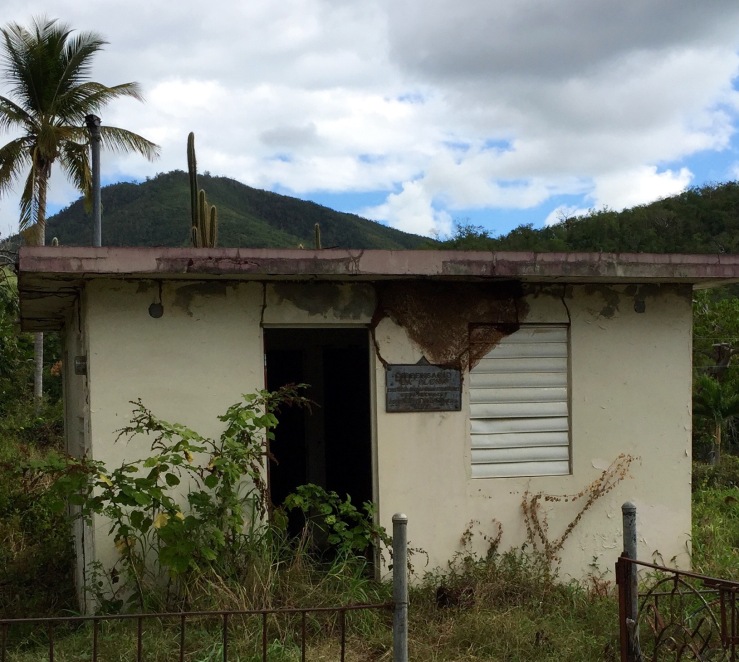
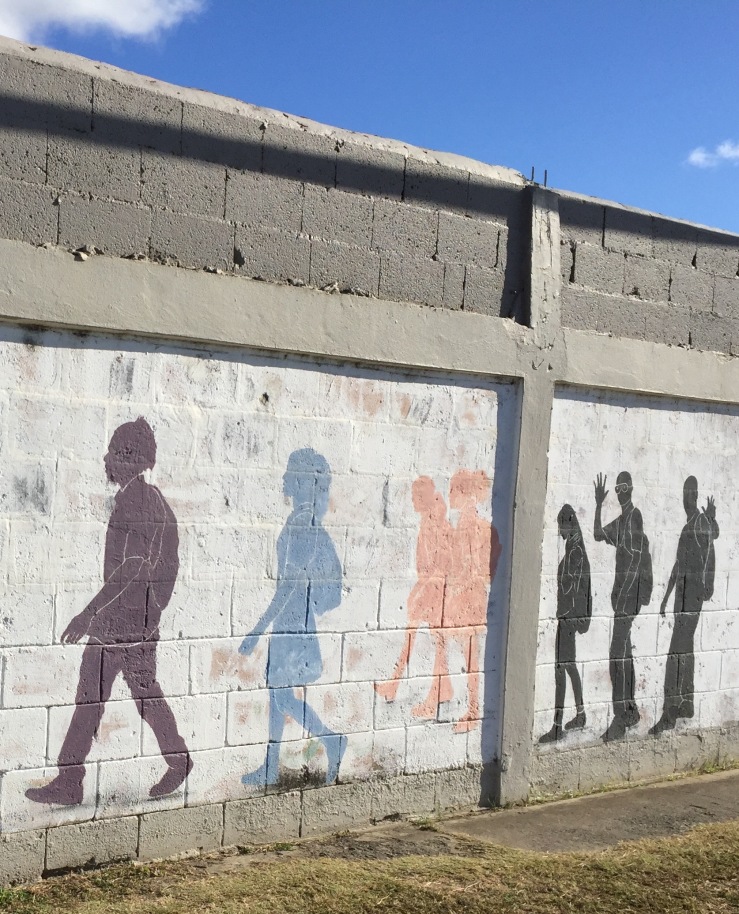


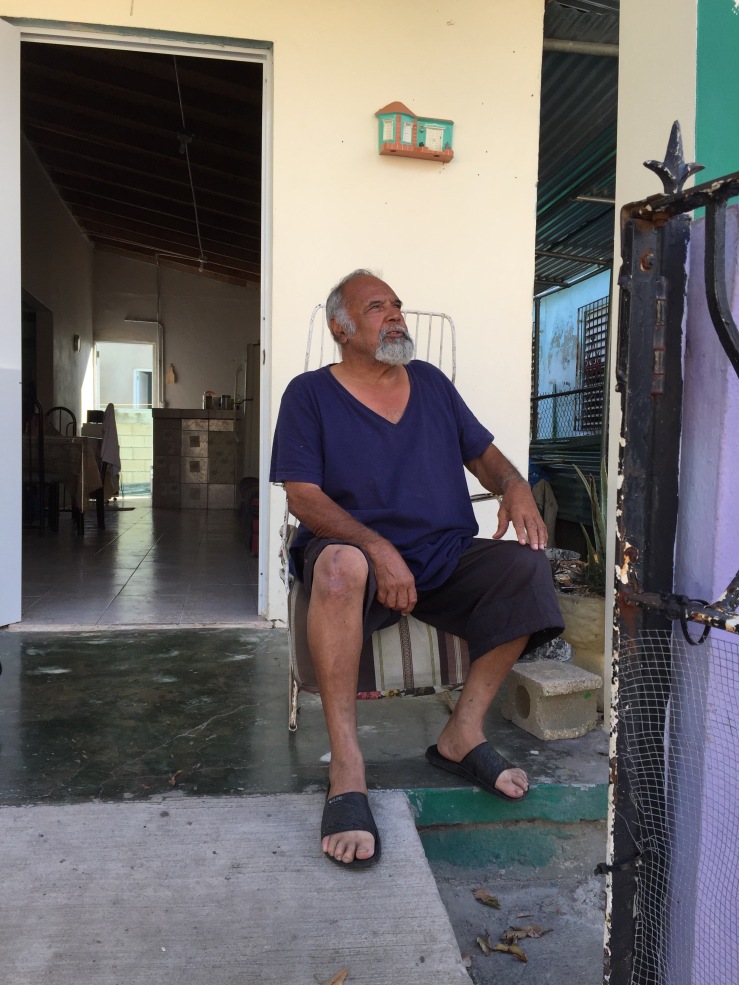


 …
…

